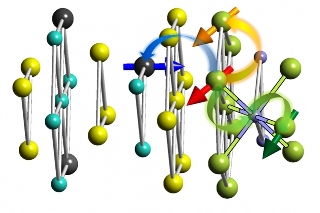MIT researchers, in collaboration with scientists from the National Institute of Standards and Technology, Northeastern University, Brookhaven National Laboratory, and Boston College, have analyzed an unusual magnetic behavior with the help of spin-polarized neutron reflectometry.
 This diagram shows the layered structure analyzed for its magnetic properties. Yellow spheres represent tellurium atoms; light blue spheres represent antimony-bismuth; and purple spheres represent sulfur. The black sphere with an arrow represents an atom of dopant, and green spheres with arrows show atoms of europium. Different colored arrows show various ways an europium ion can be affected by the interface between the materials: within the plane via Heisenberg interaction (orange), between the planes (green) through super-exchange interaction, or spin-polarized states at the topological insulator surface (blue). (Courtesy of the researchers)
This diagram shows the layered structure analyzed for its magnetic properties. Yellow spheres represent tellurium atoms; light blue spheres represent antimony-bismuth; and purple spheres represent sulfur. The black sphere with an arrow represents an atom of dopant, and green spheres with arrows show atoms of europium. Different colored arrows show various ways an europium ion can be affected by the interface between the materials: within the plane via Heisenberg interaction (orange), between the planes (green) through super-exchange interaction, or spin-polarized states at the topological insulator surface (blue). (Courtesy of the researchers)
This breakthrough discovery holds promise in the exploration of a number of exotic physical phenomena, and in the development of major components for future quantum computers. The researchers have observed the novel phenomenon at the boundary between a topological insulator and a ferromagnet. A topological insulator is a type of material that has an electrically conductive surface, but blocks flow of electricity through all of its bulk.
In this study, appearing in Physical Review Letters, the researchers have bonded a ferromagnetic layer to a topological insulator material layer. A phenomenon called proximity-driven magnetic order occurs at the interface of the two materials. As a result, a localized, controllable magnetic pattern is created at the interface.
The authors of the paper include MIT doctoral student Mingda Li, postdoc Cui-Zu Chang, professor of nuclear science and engineering Ju Li, senior scientist Jagadeesh Moodera and seven other researchers.
An energy gap, which is an essential aspect of a transistor, could be created in a topological insulator due to this “proximity magnetism” effect, said Mingda Li, the lead author of the paper. As a result, a device can be turned on and off, making it a potential building block for use in spintronics, he added. He went on to caution that “the proximity effect is usually weak," until it has the magnetic topological conductor present to "enhance it and lock new magnetic order near the interface.”
Moodera says:
This could be a building block of quantum computers. It also opens up some fundamental new phenomena for study by physicists.
“The interaction at the interface makes this exotic phenomenon possible,” Chang adds.
The proximity-induced magnetism is not only observed at the surface of the materials, but also exists within the topological insulator material.
One of the potential applications of this research is the development of transistors built on the spin of particles instead of their charge, known as spintronics. Were the spintronics based on topological insulators, they may benefit from particularly low energy dissipation.
Since the interface creates a channel without any dissipation of energy, it can serve as “a perfect quantum wire,” said Ju Li. “It cannot be better than that for a quantum conductance channel. So having this precise control of the magnetic structure could lead to novel quantum spintronics.”
Ju Li went on to say that, “In addition to near-term practical applications, from a physics point of view, the findings open up a huge area of productive work.” Exploring predicted physical phenomena like Majorana fermions is one such application. Majorana fermions are exotic particles hypothesized in 1937, but yet to be observed. They contrast all known subatomic particles by acting as their own antiparticles. “These theorized particles have yet to be explored. It opens another avenue to explore these things,” said Ju Li.
“The significance of this work is threefold,” says Qi-Kun Xue, a physics professor at Tsinghua University in China. He is not part of this research work. He said, “The three areas are to demonstrate proximity magnetism, the enhancement of such magnetism … and the tunability of this interfacial magnetic structure.”
According to him, the study results are a step towards realizing a device application of magnetic topological insulators. He explained, “In particular, the consistent results from independent experimental tools make the results robust.”
The National Science Foundation, the Office of Naval Research, and the Department of Energy supported this study.